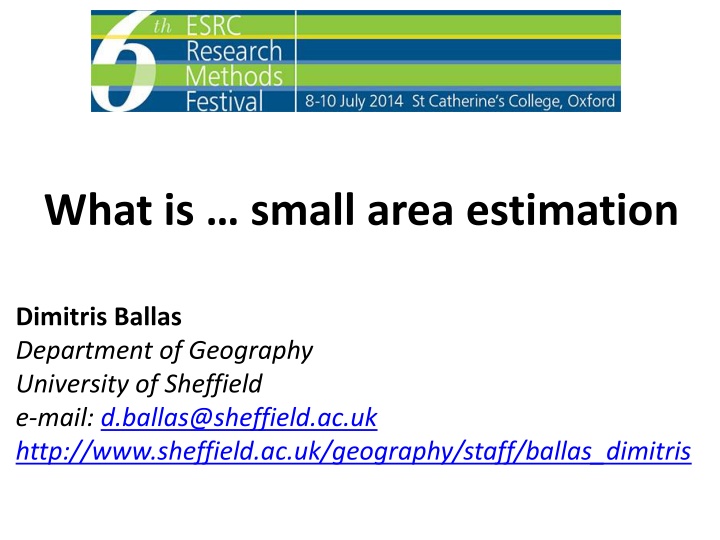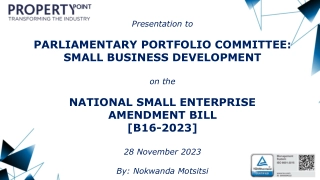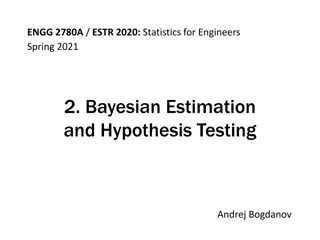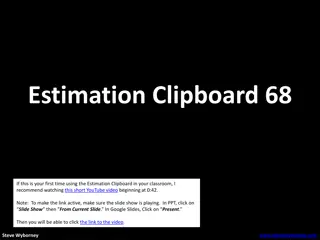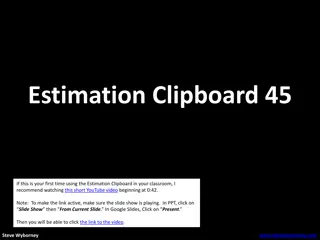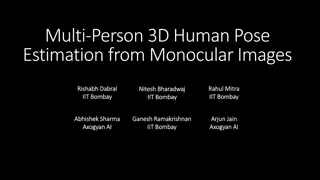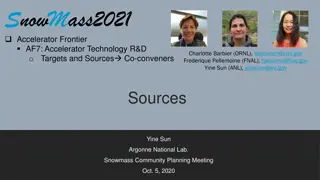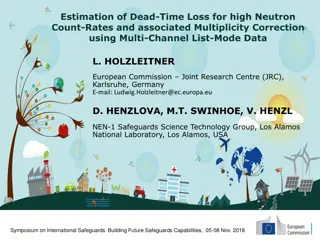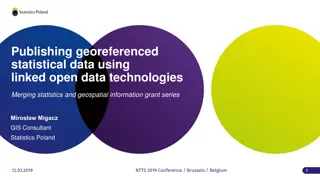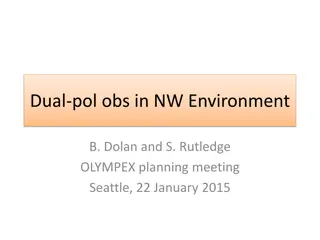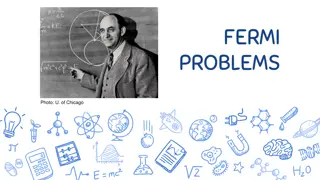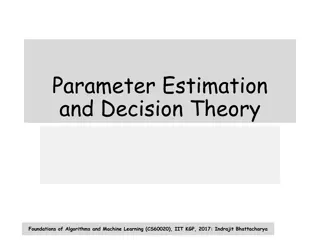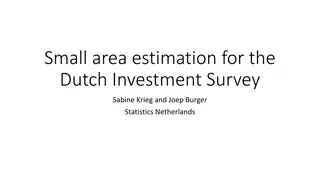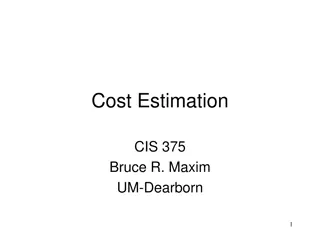Small Area Estimation: Data, Sources, and Relevance
Census data and other sources for small area estimation, policy relevance, methodological approaches, and examples discussed by Dimitris Ballas from the University of Sheffield Department of Geography.
Download Presentation

Please find below an Image/Link to download the presentation.
The content on the website is provided AS IS for your information and personal use only. It may not be sold, licensed, or shared on other websites without obtaining consent from the author.If you encounter any issues during the download, it is possible that the publisher has removed the file from their server.
You are allowed to download the files provided on this website for personal or commercial use, subject to the condition that they are used lawfully. All files are the property of their respective owners.
The content on the website is provided AS IS for your information and personal use only. It may not be sold, licensed, or shared on other websites without obtaining consent from the author.
E N D
Presentation Transcript
What is small area estimation Dimitris Ballas Department of Geography University of Sheffield e-mail: d.ballas@sheffield.ac.uk http://www.sheffield.ac.uk/geography/staff/ballas_dimitris
Outline Small area data sources Why small area estimation? Methodological approaches to small area estimation Spatial microsimulation Policy relevance examples Further reading and resources (including web-links to free software)
Small area data sources: the census of population Census data describe the state of the whole nation, area by area no other social survey has such comprehensive spatial coverage Extremely relevant for policy analysis used by government in the allocation of billions of pounds of public expenditure Very valuable commercially essential ingredients in marketing analysis and retail modelling After Rees, P, Martin, D, Williamson, P (eds) (2002), The Census Data System, Chichester, Wiley
Examples of more small area data sources Neighbourhood statistics topics (http://www.neighbourhood.statistics.gov.uk ): Census of population Crime and Safety Economic Deprivation Education, Skills and Training Health and Care Housing Physical Environment Deprivation and Classification Income and Lifestyles Population and Migration
Why small area estimation? Need for small area estimates of variables such as income, poverty, wealth, health, fear of crime, healthy lifestyles We know little about the interdependencies between household structure or type and their lifestyles at the small area level There is no live geographical database of household types linked to earning capabilities (both earned and/or transfer payments) which can be used both to explore spatial variations in lifestyles and behaviour and to monitor the effects of changes in taxation, family credit, pensions, social security payments etc.
Why small area estimation? Policy makers need small area estimates Academics need small area estimates Public like small area estimates What s happening in my backyard Policy relevance socio-economic impact assessment geographical impacts of social policy what-if socio-spatial analysis 6
Small area estimation methods Conduct a survey - very costly - confidentiality issues Small area estimation methods can be applied to get survey data down to small area level and to evaluate the spatial impacts of policies Various methodologies of small area estimation Statistical approaches Spatial microsimulation approaches Deterministic reweighting (IPF) Probabilistic reweighting (CO) Generalised linear regression (GREGWT)
Methodological approaches to small area estimation Statistical approaches (more linked to statisticians) Synthetic estimation Multi-level modelling Bayesian approaches Spatial microsimulation approaches (more linked to geographers) Deterministic reweighting approaches (IPF) Probabilistic reweighting approaches (combinatorial optimisation) Generalised linear regression (GREGWT) But many links between the methods For a review of a recent effort to explore linkages between these two often separate sets of approaches see: http://www.ncrm.ac.uk/research/NMI/2012/smallarea.php 8
A very simple approach to generating indirect non-survey designed estimates - Obtain small area total numbers from the census on variables that may be correlated with a target variable (e.g. for income would be correlated with occupational classification ) - obtain information at the national, or sometimes regional level information on the same variable cross-tabulated by the census variable (e.g. earnings by occupational classification) - multiply the known census totals by average value for each area
A model-based approach (Office for National Statistics, Heady et al., 2003) Estimating average weekly household at the electoral ward level in England and Wales on the basis of the following predictors: the social class of the ward population; Household type/composition Regional/country indicators the employment status of the ward population the proportion of the ward population claiming DWP benefits; the proportion of dwellings in each of the Council Tax bands in a ward The model-based approach is based on finding a relationship between weekly household income (as measured in the Family Resources Survey (FRS)) and covariate information (usually from Census or administrative sources) for the wards that are represented in the Survey see http://www.neighbourhood.statistics.gov.uk/HTMLDocs/images/Model- Based_Income_Estimates%28V2%29_tcm97-51115.pdf
Spatial Microsimulation A technique aiming at building large scale data sets Modelling at the microscale A means of modelling real life events by simulating the characteristics and actions of the individual units that make up the system where the events occur
What is microsimulation? PERSON AHID PID AAGE12 SEX AJBSTAT AHLLT AQFVOC ATENURE AJLSEG 1 1000209 10002251 91 2 4 1 1 6 9 2 1000381 10004491 28 1 3 2 0 7 -8 3 1000381 10004521 26 1 3 2 0 7 -8 4 1000667 10007857 58 2 2 2 1 7 -8 5 1001221 10014578 54 2 1 2 0 2 -8 6 1001221 10014608 57 1 2 2 1 2 -8 7 1001418 10016813 36 1 1 2 1 3 -8 8 1001418 10016848 32 2 -7 2 -7 3 -7 9 1001418 10016872 10 1 -8 -8 -8 3 -8 10 1001507 10017933 49 2 1 2 0 2 -8 11 1001507 10017968 46 1 2 2 0 2 -8 12 1001507 10017992 12 2 -8 -8 -8 2 -8
Static spatial microsimulation Reweighting probabilistic approaches, which typically reweight an existing national microdata set to fit a geographical area description on the basis of random sampling and optimisation techniques Reweighting deterministic approaches, which reweight a non geographical population microdata set to fit small area descriptions, but without the use of random sampling procedures Synthetic probabilistic reconstruction models, which involve the use of random sampling
Static spatial microsimulation PERSON AHID PID AAGE12 SEX AJBSTAT AHLLT AQFVOC ATENURE AJLSEG 1 1000209 10002251 91 2 4 1 1 6 9 2 1000381 10004491 28 1 3 2 0 7 -8 3 1000381 10004521 26 1 3 2 0 7 -8 4 1000667 10007857 58 2 2 2 1 7 -8 5 1001221 10014578 54 2 1 2 0 2 -8 6 1001221 10014608 57 1 2 2 1 2 -8 7 1001418 10016813 36 1 1 2 1 3 -8 8 1001418 10016848 32 2 -7 2 -7 3 -7 9 1001418 10016872 10 1 -8 -8 -8 3 -8 10 1001507 10017933 49 2 1 2 0 2 -8 11 1001507 10017968 46 1 2 2 0 2 -8 12 1001507 10017992 12 2 -8 -8 -8 2 -8
Static spatial microsimulation Small area table 1 (household type) Area 1 Small area table 2 (number of cars) Area 1 Small area table 3 (tenure status) Area 1 60 "married couple households" 10 no car 60 owner occupier 20 "Single-person households" 80 1 car 20 Local Authority or Housing association 20 "Other" 10 2+ cars 20 Rented privately Area 2 Area 2 Area 2 40 "married couple households" 40 no car 60 owner occupier 20 "Single-person households" 40 1 car 20 Local Authority or Housing association 40 "Other" 20 2+ cars 20 Rented privately
Tenure and car ownership example Household car ownership characteristics 1 car cars 27 24 50 20 23 4 Household tenure characteristics 2+ No car 49 30 19 Owner- occupier 39 60 21 LA/HA rented 17 10 7 Other Simulation Census Absolute error 44 30 14
Combinatorial optimisation: simulated annealing Origins in thermodynamics Metropolis et al. (1953) suggested an algorithm for the efficient simulation of the evolution of a solid material to thermal equilibrium Annealing is a physical process in which a solid material is first melted in a heat bath and then it is cooled down slowly until it crystallises First used in a spatial microsimulation context by Williamson, P., Birkin, M., Rees, P. (1998), The estimation of population microdata by using data from small area statistics and samples of anonymised records, Environment and Planning A, 30, 785-816
Other methodologies Hill-climbing, genetic algorithms Deterministic reweighting approaches Probabilistic synthetic reconstruction techniques (IPF- based approaches)
Deterministic Reweighting the British Household Panel Survey (BHPS) - a simple example (1) A hypothetical sample of individuals (list format) Individual sex age-group weight 1st male over-50 1 2nd male over-50 1 3d male under-50 1 4th female over-50 1 5th female under-50 1 Hypothetical Census data for a small area: In tabular format: age/sex under-50 over-50 male female 1 2 age/sex under-50 over-50 male female 3 3 1 1 5 1
Reweighting the BHPS - a simple example (2) Calculating a new weight, so that the sample will fit into the Census table Individual sex 1st 2nd 3d 4th 5th age-group weight New weight over-50 1 over-50 1 under-50 1 female over-50 female under-50 1 x 3/2 = 1.5 1 x 3/2 = 1.5 1 x 3/1 = 3 1 x 1/1 = 1 1x 5/1 = 5 male male male 1 1 Hypothetical Census data for a small area: In tabular format: age/sex under-50 over-50 male female 1 2 age/sex under-50 over-50 male female 3 3 1 1 5 1
Probabilistic synthetic reconstruction After Birkin, M., Clarke, M. (1988), SYNTHESIS a synthetic spatial information system for urban and regional analysis: methods and examples, Environment and Planning A, 20, 1645-1671
Probabilistic synthetic reconstruction techniques Steps Age, sex and marital status and location (DED level) (given) 1st Age: 25 Sex: Male Marital Status: Single GeoCode: Leitrim Co., DED 001 Ballinamore 0.7 2nd Age: 76 Sex: Female Marital Status: married GeoCode: Leitrim Co., DED 002 Cloverhill 0.2 Last Age: 30 Sex: Male Marital Status: married GeoCode: Leitrim Co., DED 078 Rowan 0.7 Probability of hh of given age , sex and location (ED level) being at work Random number Economic activity assigned to hh on the basis of random sampling Probability (conditional upon the above attributes) of hh being an employee in the Agriculture industry Random number Economic activity category assigned on the basis of random sampling 0.55 At work 0.5 Other (e.g. Retired) 0.45 At work 0.6 0.2 0.4 Employee in Agriculture 0.6 Not an employee in Agriculture SMILE model, after Ballas, D., Clarke, G. P., Wiemers, E., (2006) Spatial microsimulation for rural policy analysis in Ireland: The implications of CAP reforms for the national spatial strategy, Journal of Rural Studies, vol. 22, pp. 367-378 (doi:10.1016/j.jrurstud.2006.01.002)
Dynamic spatial microsimulation Probabilistic dynamic models, which use event probabilities to project each individual in the simulated database into the future (e.g. using event conditional probabilities). Implicitly dynamic models, which use independent small area projections and then apply the static simulation methodologies to create small area microdata statically
Probabilistic dynamic models Steps Age, sex and marital status and location (DED level) (given) 1st Age: 25 Sex: Male Marital Status: Single GeoCode: Leitrim Co., DED 001 Ballinamore 0.30 2nd Age: 76 Sex: Female Marital Status: married GeoCode: Leitrim Co., DED 002 Cloverhill 0.05 Last Age: 30 Sex: Male Marital Status: married GeoCode: Leitrim Co., DED 078 Rowan 0.26 Probability (conditional upon age, sex, location) of hh to migrate Random number Migration status assigned on the basis of random sampling Probability (conditional upon age, sex, location) of hh to survive Random number Survival status 0.2 Migrant 0.4 Non-migrant 0.4 Non-migrant 0.9 0.5 0.8 0.5 Survived 0.4 Deceased 0.4 Survived after Ballas D , Clarke, G P, Wiemers, E, (2005) Building a dynamic spatial microsimulation model for Ireland , Population, Space and Place, 11, 157 172 (http://dx.doi.org/10.1002/psp.359)
SimBritain: combining Census data with the BHPS Census of UK population: 100% coverage fine geographical detail Small area data available only in tabular format with limited variables to preserve confidentiality cross-sectional British Household Panel Survey: sample size: more than 5,000 households Annual surveys (waves) since 1991 Coarse geography Household attrition Ballas, D. , Clarke, G.P., Dorling, D., Eyre, H. and Rossiter, D., Thomas, B (2005) SimBritain: a spatial microsimulation approach to population dynamics, Population, Space and Place 11, 13 34 (http://dx.doi.org/10.1002/psp.351)
SimBritain modelling approach 1. 2. 3. 4. 5. 6. 7. 8. Establish a set of constraints Choose a spatially defined source population Repeatedly sample from source Adjust weightings to match first constraint Adjust weightings to match second constraint Adjust weightings to match final constraint Go back to step 4 and repeat loop until results converge Save weightings which define membership of SimBritain 9.
CONSTRAINT TABLES TABLE CATEGORY Car Ownership no cars 1 car 2+ cars Social Class affluent middle income less affluent Demography 1 child 2+ children no children Employment active retired inactive Households married couple lone parent other Tenure owner occupied council tenant other
How do we know it makes sense? Average age se = 1.0 r squared = .760 beta = 1.22 RR cage 50 48 46 44 42 40 38 36 34 32 30 30 32 34 36 38 40 42 44 46 48 50 sage
How do we know it makes sense? Long-term illness se = 1.7 r squared = .767 beta = 1.19 cill 0.30 0.25 0.20 0.15 0.10 0.05 0.00 0.00 0.05 0.10 0.15 0.20 0.25 0.30 sill
The potential of microsimulation for policy analysis Classifying households Very poor: all households with income below 50% of the median York income Poor: all households with income more than 50% of the median but lower than 75% of the median Below-average: all households living on incomes higher than 75% of the median but less than or equal to the median Above-average: all households living on incomes higher than the median and lower than 125% of the median Affluent: all households living on incomes above 125% of the median Ballas, D., Clarke, G P, Dorling D, Rossiter, D. (2007), Using SimBritain to Model the Geographical Impact of National Government Policies, Geographical Analysis 39, pp.44-77 (doi:10.1111/j.1538-4632.2006.00695.x)
Living standards of very poor households Very poor households 1991 2001 2011 2021 Households (% of all households in York) Individuals (% of all individuals in York) Children (% of all children in York) LLTI (as a % of all individuals in group) Elderly (over 64 years as a % of all individuals in group) Individuals in group with father's occupation: unskilled (%) Reporting anxiety and depression (% of all individuals in group) Reporting health problems with alcohol or drugs (% of all individuals in group) 17.2% 14.7% 21.8% 9.0% 17.3% 13.3% 17.7% 7.3% 17.8% 13.7% 18.6% 5.4% 21.3% 20.5% 38.5% 7.9% 30.1% 32.0% 33.3% 44.2% 10.5% 6.8% 3.3% 15.1% 10.6% 10.3% 7.4% 3.1% 0.9% 1.1% 0.3% 0.0% Individuals who reported that they have no one to talk to 19.9% 23.8% 31.1% 31.5%
Using SimBritain to Model the Geographical Impact of National Government Policies Working Families Tax Credits Amount in 2002-3 60.00 Adjusted for 1991 42.39 Couple or lone parent Child aged under 16 26.35 18.62 16-18 27.20 19.22 30 hours credit 11.65 8.23 Disabled child credit 35.50 25.08 Enhanced disability credit Couple or lone parent 16.25 11.48 Child 46.75 33.03 Childcare credit One child 70% of up to 70% of up to 95.39 70% of up to 141.31 16.04 135 Two or more children 70% of up to 200 22.70 Additional partners in a polygamous marriage
Further reading and resources (including software) Combinatorial Optimisation software (including dummy dataset and associated documentation) by Paul Williamson (University of Liverpool): http://pcwww.liv.ac.uk/~william/microdata/CO%20070615/CO_software.html Iterative Proportional Fitting and integerisation R code and data: Lovelace, R, Ballas D (2013), Truncate, replicate, sample : A method for creating integer weights for spatial microsimulation, Computers, Environment and Urban Systems, http://www.sciencedirect.com/science/article/pii/S0198971513000240 (open access article including publicly available R code and data) A recent review of the state of the art and research challenges by Adam Whitworth (University of Sheffield):Whitworth, A et al. (2013) Evaluations and improvements in small area estimation methodologies. Discussion Paper. NCRM http://www.ncrm.ac.uk/research/NMI/2012/smallarea.php and http://eprints.ncrm.ac.uk/3210/ ). This includes a Spatial Microsimulation R-Library by Dimitris Kavroudakis (University of the Aegean) including R code available from: http://www.shef.ac.uk/polopoly_fs/1.268326!/file/sms_Manual_v9.zip An introductory text to spatial microsimulation:Ballas, D., Rossiter, D, Thomas, B., Clarke G, Dorling D, (2005), Geography matters: simulating the local impacts of national social policies, Joseph Roundtree Foundation http://www.jrf.org.uk/sites/files/jrf/1859352669.pdf 2-day NCRM/TALISMAN course: An Introduction to Spatial Microsimulation Using R, 19-20 September 2014, University of Cambridge http://store.leeds.ac.uk/browse/extra_info.asp?compid=1&modid=2&deptid=9&catid=47&pr odid=449
